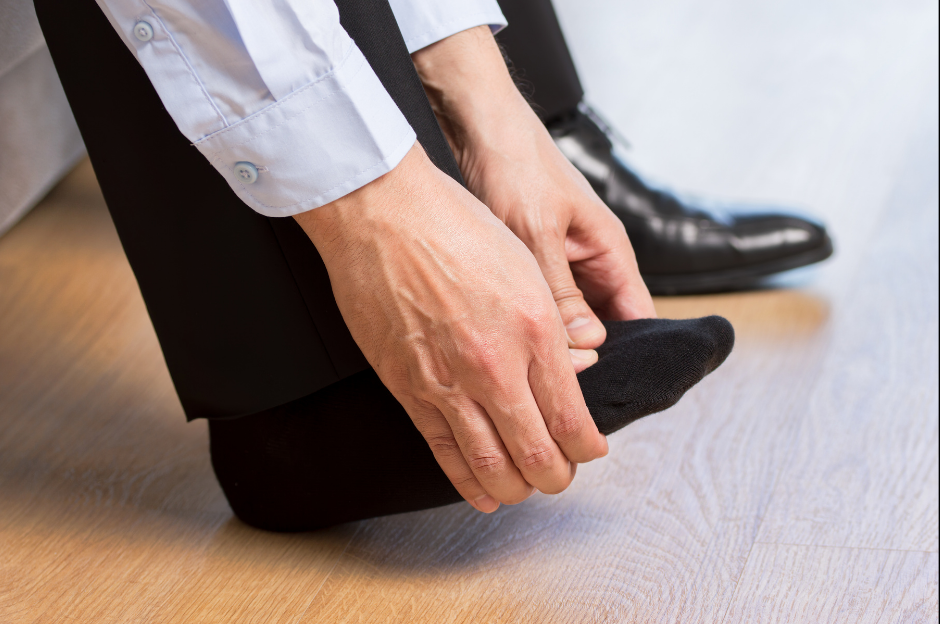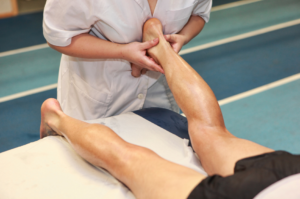Foot pain can be a debilitating condition that significantly impacts our daily lives – hindering our mobility, causing discomfort, and reminding us that our foot is injured with every step, literally. Most people will know that booking in with the right health professional fairly promptly can make all the difference in getting started on getting relief from your symptoms, as well as addressing the underlying issues that keep foot pain returning. So who should you be booking in with: a podiatrist, an orthopaedic surgeon, or a physiotherapist?
Podiatrists
Podiatrists are dedicated foot and ankle specialists that have a wealth of knowledge and expertise in diagnosing, treating, and preventing a wide array of foot conditions. They treat foot and leg pain exclusively, with all podiatry-related training and education focusing specifically on the complexities of the lower extremities. From biomechanics to foot pathology, podiatrists are generally regarded as the go-to health professionals for foot injuries, conditions and maintaining foot health.
Podiatrists are qualified to diagnose a wide range of issues such as bunions, plantar fasciitis heel pain, ingrown toenails, and everything in between. Whether it’s assessing gait abnormalities, prescribing custom foot orthotics, or performing minor surgical procedures for warts or ingrown nails, podiatrists offer a comprehensive range of treatments that are always tailored to your specific needs so you can get the best results for your foot health.
What sets podiatrists apart is their proactive approach to foot care. Beyond just treating existing conditions and giving you much-needed symptoms relief, they emphasise preventive measures to maintain optimal foot health for your lifetime. Through making simple and effective changes – like via muscle strengthening, footwear recommendations, lifestyle modifications and altering your gait using orthotics (where needed), they empower patients to take charge of their foot wellness and help prevent future problems from arising.
Orthopaedic Surgeons
Orthopaedic surgeons are the go-to specialists for more complex and intricate foot issues that may require surgery, whether major or minor. Orthopaedic surgeons are doctors that then specialise in lower limb surgery. They are very highly skilled and trained, with a very thorough understanding of the musculoskeletal system and what’s going on ‘beneath the surface’.
Orthopaedic surgeons excel in surgical management of foot and leg pains, problems and conditions.
When conservative (non-operative) measures fall short, are unavailable, or don’t produce the desired results, orthopaedic surgeons step in with precision and expertise to correct deformities, remove masses, repair fractures, and work with a range of conditions to alleviate pain and dysfunction. From ankle arthroscopy to joint replacements, they offer a range of surgical options tailored to the individual needs of each patient.
If you have not yet seen anyone for your foot pain, an orthopaedic surgeon generally will not be your first port of call. This is because they do not perform ‘simpler’ treatments like removing a corn or prescribing some custom orthotics for heel pain. Surgery also takes a significant toll on the body and naturally carries risks, so is typically not considered a ‘first line’ treatment option, unless you have a very specific problem where no other options are available. Those that have surgery are generally in circumstances where the benefits will outweigh any risks in their unique circumstances.
Physiotherapists
Physiotherapists play a crucial role in the holistic management of foot pain, focusing on rehabilitation and restoring function. While they may not specialise exclusively in foot care, their expertise in musculoskeletal health makes them valuable allies in the journey towards pain relief and recovery.
When you consult a physiotherapist for foot pain, you can expect a comprehensive assessment of your overall musculoskeletal function. They employ a variety of techniques, including manual therapy, exercise prescription, and gait analysis, to address underlying imbalances and weaknesses contributing to your symptoms.
While physiotherapists may not have the same level of eagle-eye knowledge in foot anatomy and pathology as podiatrists, they bring a unique perspective to the table given their knowledge on human movement and function. By addressing broader musculoskeletal issues and promoting overall mobility and function, they complement podiatric care and contribute to long-term foot health. We work very closely with physiotherapists and respect their work greatly. If we believe you could benefit from physiotherapy alongside your podiatry treatment, we will always refer you to one of our trusted physiotherapy partners.
Who Should I See For Foot Pain?
When experiencing foot pain, the generally recommended first point of call will be your podiatrist. Situations where this would differ was if you had a foot infection and needed antibiotics, in which case we’d recommend seeing your general practitioner. We haven’t included GP’s on this list because we find that most GP’s will simply refer to or recommend a podiatrist anyway, given that they do not provide any general musculoskeletal care or services.
Takeaways:
- Podiatrists should be the first point of contact for most foot-related concerns due to their specialised training and focus on foot health. They can accurately diagnose conditions, provide tailored foot and leg specific treatments, and offer preventive strategies to maintain foot health.
- Orthopaedic surgeons are valuable for complex cases requiring surgical intervention or when conservative treatments have been ineffective. Patients with severe deformities, fractures, or advanced arthritis may benefit from their expertise. Your podiatrist or GP typically tends to give you a referral to see an orthopaedic surgeon.
- Physiotherapists complement podiatric care by focusing on overall musculoskeletal function and rehabilitation. They play a vital role in enhancing mobility, reducing pain, and preventing recurrence of foot issues, especially in conjunction with podiatry interventions.






 A one-off pain at the back of your heel at your Achilles tendon that starts but then shortly subsides for good is one thing. Ongoing Achilles pains and problems that keep reappearing – or even worse, never truly go away – takes the problem to a whole new level of discomfort, frustration and pain.
A one-off pain at the back of your heel at your Achilles tendon that starts but then shortly subsides for good is one thing. Ongoing Achilles pains and problems that keep reappearing – or even worse, never truly go away – takes the problem to a whole new level of discomfort, frustration and pain.


 Ladies, before we dive into the fashion vs. comfort talk, the good news is that these days you can find great-feeling, great-looking shoes that are absolutely work-appropriate. Yay! The people have spoken and the shoe manufacturers have listened and provided us with a number of options. We love the range from Frankie4 and Ziera. Better yet, they have built-in arch support too! There are plenty of other great brands around – just try them on, and if it feels like you’re walking on a cloud and your foot is supported, then you’re on to a winner.
Ladies, before we dive into the fashion vs. comfort talk, the good news is that these days you can find great-feeling, great-looking shoes that are absolutely work-appropriate. Yay! The people have spoken and the shoe manufacturers have listened and provided us with a number of options. We love the range from Frankie4 and Ziera. Better yet, they have built-in arch support too! There are plenty of other great brands around – just try them on, and if it feels like you’re walking on a cloud and your foot is supported, then you’re on to a winner. Retail store floors can be made from all sorts of materials these days. We’ve been noticing quite a few bare concrete floors in more boutique-style retail stores as they go for the minimalist and high-end feel. The upside? Trendy. The much more significant downside? Concrete is a tough surface for your feet, especially during long shifts. If this is you, we’d invest in a cushioned mat for behind the counter, or wherever you find yourself working often and is out of sight. If it decreases your soreness and increases your happiness (and hence service or productivity), your manager may be very much on board.
Retail store floors can be made from all sorts of materials these days. We’ve been noticing quite a few bare concrete floors in more boutique-style retail stores as they go for the minimalist and high-end feel. The upside? Trendy. The much more significant downside? Concrete is a tough surface for your feet, especially during long shifts. If this is you, we’d invest in a cushioned mat for behind the counter, or wherever you find yourself working often and is out of sight. If it decreases your soreness and increases your happiness (and hence service or productivity), your manager may be very much on board.

 On our end, we conduct a comprehensive biomechanical assessment in which we:
On our end, we conduct a comprehensive biomechanical assessment in which we: